The debate on Raja Raja Chola's supposed final resting place in Udayalur, Thanjavur, continues, with ongoing efforts to verify claims and gain government attention.
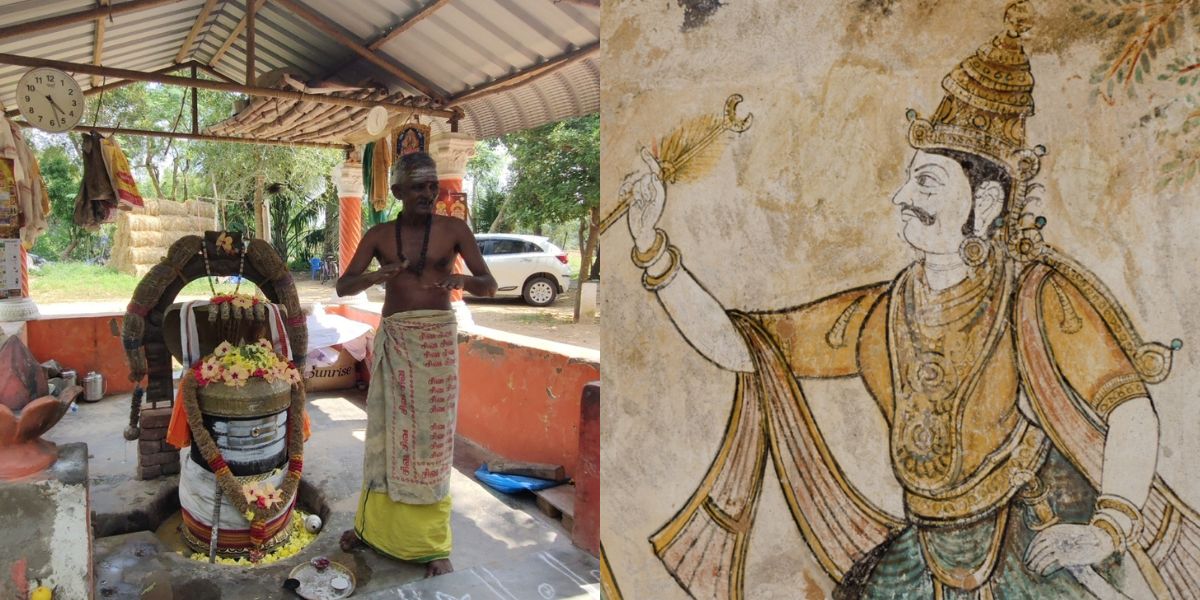
Among the Chola empire's illustrious rulers, Raja Raja Chola is particularly renowned. (Roshne Balasubramanian/South First)
In the realm of antiquities and the study of ancient empires, certain mysteries have captured the imagination of historians, enthusiasts, and the general public alike. For example, the search for the lost tombs of Alexander the Great and Cleopatra has fascinated people for centuries. However, a similar quest has been underway in southern India, in Thanjavur, for a king who expanded his influence far beyond the region.
For those acquainted with the history of dynasties that thrived in southern India, the Chola dynasty stands out. This dynasty played an important role in fostering language, literature, architecture, wealth, and power in the region. Among its illustrious rulers, Raja Raja Chola is particularly renowned. He reigned from 985 CE to 1014 CE, leaving a significant mark on history. Despite his prominence, details of his death are sparse, and the location of his final resting place remains a mystery.
However, claims have surfaced suggesting that a specific site in Udayalur, a village in Kumbakonam, Thanjavur district, could be the resting place of this influential monarch. Notably, Raja Raja Chola is credited with commissioning the construction of the Brihadeeshwara temple, now designated as a UNESCO World Heritage Site.
In pursuit of this mystery, this reporter embarked on a journey to Udayalur, located about eight kilometres from Kumbakonam. Navigating with the aid of Google Maps, we traversed through lush fields and picturesque landscapes until we reached our destination.
Our arrival was marked by an unassuming narrow lane. A signboard read: “Raja Raja Chola Mamannan Ninaividam” (Resting place of The Great King Raja Raja Chola). The signboard also provided additional information, including the period of the king’s reign, his birth name – Arulmozhi Varman, and one of the former names of the village – Sivapadha Sekara Mangalam.
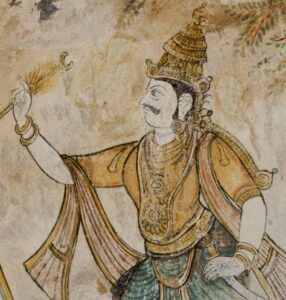
A mural of Raja Raja Cholan. (Wikipedia)
Stepping out of our vehicle, we proceeded down the lane, passing by quaint houses and the occasional sight of locals going about their daily routines. As we continued, the landscape transitioned into banana plantations. Eventually, the path revealed a clearing where a concrete shelter stood, painted in hues of orange and white.
Our attention was drawn to an elderly man, dressed in traditional attire. He emerged from a chair outside the shelter upon noticing our arrival. With practised ease, he lit camphor on a plate, offering it in reverence to a sizable Shiva Lingam embellished with flowers. “I am Jayaraman, a native of Udayalur. I serve as a part-time priest here,” he introduced himself.
As our inquiries about the claimed resting place of Raja Raja Chola began, Jayaraman gestured towards the Shiva Lingam and recounted a tale from decades past. “While tending to the plantation, we stumbled upon a partially buried Shiva Lingam, deeply embedded in the earth,” he said.
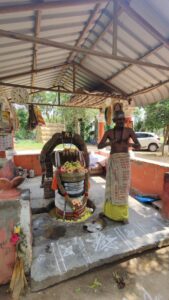
Jayaraman. (Roshne Balasubramanian/South First)
Recognising its significance, Jayaraman’s father, Pakirisamy realised that they had discovered something of great importance — a discovery that has since become the focal point of speculation and reverence in the community.
According to historians, in ancient times, it was customary to mark the Pallipadai (burial site) of a ruler by burying their ashes in the ground and erecting a Shiva Lingam atop it, which would then be consecrated. This tradition held immense importance in honouring and commemorating the departed rulers.
“So, the discovery of a Lingam indicated the presence of a significant burial site. Potentially that of the Chola King,” shares Jayaraman.
The discovery gained significance due to its proximity to Pazhaiyarai, the ancient capital of the medieval Cholas. Additionally, Raja Raja Chola’s wife, Panchavan Madevi’s Pallipadai, lies roughly 5 kilometres from this site in Pateeswaram. These connections fueled speculation about the site’s potential association with the Chola King.
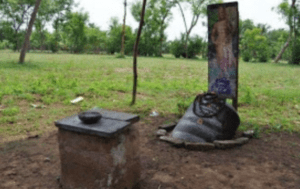
When the Lingam was discovered, it was slanted and partially buried. (X – @Dr.SushmaShallakaul)
Pointing to a nearby granite structure, perhaps a remnant of an older construction part of a mandapam (a pillared hall), Jayaraman further emphasised the historical significance of the site.
“Visitors often express dismay at the modesty of the current shelter, considering it the resting place of such a great king,” he shared.
However, to comfort such visitors, Jayaraman often offers a perspective rooted in history. “Over the centuries, the region had witnessed the rise and fall of various rulers. The Pandya conquest occurred in the 13th century, during which many Chola structures were destroyed. Consequently, the original grandeur of the burial site might have been diminished or lost entirely due to such historical turmoils,” he shared.
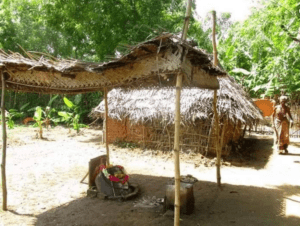
The current concrete shelter was built only in recent years. (Facebook – Lost Temples)
The present shelter had been constructed around the Shiva Lingam only in recent years. The land on which the shelter stands is owned by Jayaraman and his family, under an annual lease arrangement. Taking pride in their heritage, the residents have taken it upon themselves to maintain the site.
Jayaraman’s name and number are plastered over a few posters leading towards the shelter as the site’s caretaker. “Minor donations from visitors are utilised for purchasing ritual items and maintaining the premises, ensuring that the memory of the king is upheld with dignity and respect,” said Jayaraman.
In recent years, with the rise of content creators, the site has often become a clickbaity attraction, featuring titles such as “Here Rests Raja Raja Chola” and other attention-grabbing phrases.
However, the authenticity of the claim remains a subject of debate and investigation. An archaeologist from the Trichy circle, who has been involved in the investigations, sheds light.
According to the official, the claims are primarily based on an inscription discovered a few decades ago.
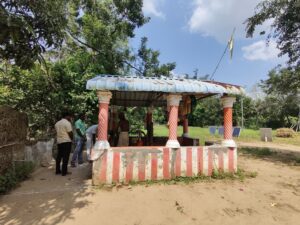
Jayaraman maintains the temple with donations from visitors. (Roshne Balasubramanian/South First)
The inscription, found in a pillar at the Palkulatthi Amman Temple, dates back to the regnal years 42 of Kulotthunga-Chola-I (1112 CE), a descendant of Raja Raja.
“The temple is situated on the southern side of the village, just 0.5 km south of the Siva Lingam. This inscription, documented in the Annual Report on Indian Epigraphy (1926-1929) and published in 1986, details the renovation of the front portion of the mandapam, located in front of the temple of ‘Rajarajadevar’ alias ‘Sivapada Sekaradeva’ in the village of Sivapada Sekaramangalam (Udayalur),” shared the ASI official. Sivapada Sekaran is a title famously given to Raja Raja Chola – who was a devoted Shaivite.
The inscription provides insights into the historical context of the temple and the village during that period. It mentions the “reconstruction of a mandapam by Velan Arikesan, also known as Kachchirayar of Pidavur”.
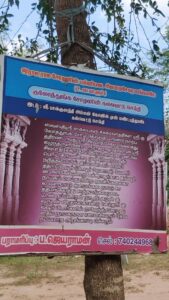
The inscription, found in a stone pillar at the Palkulatthi Amman Temple on display. (Roshne Balasubramanian/South First)
However, the archaeologist emphasises that this inscription is the sole indication of a mandapam’s existence in the vicinity. “There is no direct evidence linking this site to the burial place of Raja Raja Chola. Despite claims, the lack of concrete evidence poses a challenge in confirming the authenticity of the purported resting place,” said the official.
In 2019, in response to a PIL, demanding the construction of a memorial for the late king, the Madras High Court ordered a probe. A committee was tasked with inspecting Udayalur to determine the presence of archaeological remains or artefacts that could provide evidence of the king’s burial.
Various methods, including Geographical Information System and Ground Penetrating Radar System, were employed during the investigation. Yet, no findings could conclusively link the site to Raja Raja Chola’s resting place.
“However, continued exploration and investigation are important,” added the official, indicating that the quest for the true resting place of Raja Raja Chola continues.
“We’re eager for the government to give this site the attention it deserves. After all, our revered king should have a more fitting resting place,” shared Jayaraman, convinced that this is where “His king” rests.
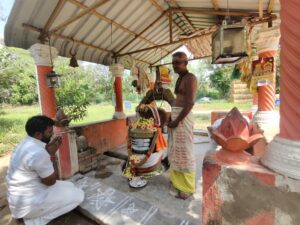
A visitor offering prayers at the site in Udayalur, Thanjavur. (Roshne Balasubramanian/South First)
As we readied ourselves to depart, a group of enthusiasts from Chennai arrived, their faces alive with curiosity. Jayaraman lit the ritual plate with camphor once more, deftly battling the gusts of wind.
“What’s the story behind this place?” asked one visitor, their fascination palpable as they surveyed the humble surroundings.
“Ah, this is where the Great King Raja Raja Cholan lies…” Jayaraman began, his voice carrying the weight of centuries-old tales. Until proven otherwise, this spot may well hold the hues of the king’s legacy, a place where stories of his bravery continue to captivate hearts near and far.

Apr 26, 2024

Apr 25, 2024

Apr 24, 2024

Apr 19, 2024

Apr 19, 2024

Apr 19, 2024